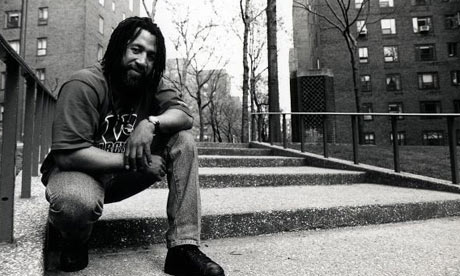
DJ Kool Herc: 'When I extended the break, people were ecstatic, because that was the best part of the record to dance to.'
Considering the event is thought to be the birth of a globe-spanning, music-based culture almost half a century old, the ambitions that lay behind it were endearingly modest. Cindy Campbell just wanted to raise a bit of money before the new school term began to buy some clothes from boutiques on Delancey Street, 10 miles south on Manhattan's Lower East Side, rather than wear the same clothes as her classmates who'd be shopping nearer home. So she hired the first-floor recreation room of the 100-unit apartment building they lived in, at 1520 Sedgwick Avenue, and threw a party. The main attraction? Her 16-year-old brother, Clive – his height and muscles earned him the nickname Hercules – and his record collection.
The flyer was hand-drawn, on lined index file cards. "A DJ Kool Herc Party," it read, in a quick pencil approximation of the elaborate spraycan slogans then appearing all over the Bronx: "Back to school jam." The 9pm-4am party wasn't going to break anyone's bank: admission charges were 50c for "fellas", 25c for ladies. Clive and Cindy's dad got the drinks from a local cash-and-carry; their mum made some food.
Clive's friend, Coke La Rock, decided to shout out names of other friends over the drum-heavy introductions and instrumental breakdowns Clive had decided to play. The room held 300 people; they all had a great time. No one had heard of DJ Kool Herc before that night: the next day, he was famous across the Bronx. Soon, he'd be hailed as the architect of an entirely new music.
Herc's playlist was eclectic, and paid little heed to the trends of the day. A recent not-quite-hit such as It's Just Begun by the Jimmy Castor Bunch became an anthem for what was soon a large and growing audience. He'd play James Brown, but not the singles – rather, raw cuts from live albums. And when he came across a record with the right ingredients, it didn't matter what genre it came from - English prog rockers Babe Ruth and the Edgar Winter Group's Frankenstein got spun in Herc's sets, too.
By 1974, Herc was playing outdoors in the summer – in Cedar Park, where the decks and sound systems drew power from streetlights. But he was also getting booked at Bronx clubs, and one night he decided to spin the percussion breakdown from two copies of the same record one after the other, effectively replaying the break and extending it. The record was either Bongo Rock or Apache, by the Incredible Bongo Band. "And when I extended the break, people were ecstatic, because that was the best part of the record to dance to, and they were trippin' off it," he said in 1997.
The part of his set he came to call "the merry-go-round" was one of the key creative decisions of 20th-century music – from that moment of inspiration, or madness, came the concept of breakbeats, and then sampling and digital music production technology, as well as more or less every kind of loop-based composition technique. Why did he do it?
"Boredom?" he chuckled. "I mean, really! I was sittin' back, observin', watching the crowd who were all waiting for this particular part of the record. And after I did it for the first time, there was no turnin' back – everybody was comin' to the party for that particular part of my set."
Part of the reason Herc's innovations had such impact was that they happened amid a wider cultural explosion. The promoter and scenester Fab 5 Freddy would later codify DJing, MCing, breakdancing and graffiti as the four elements of hip-hop – proving, Freddy argued, that this wasn't just a craze, but a fully fledged culture. Herc says that the dancers he dubbed B-boys were inspired by James Brown – "That's the king, the A-1 B-boy; way back, in '68 or '69, whenever you went to a party there was always some good dancers" – and graffiti tags were widespread in New York by 1971. The DJing came next, with Herc vying for pre-eminence mid-decade with the other two members of hip-hop's founding holy trinity, Afrika Bambaataa and Grandmaster Flash. The rappers were the last to emerge, so Coke's innovations on 13 August only hinted at the style that would complete the cultural cypher.
Never a showman on the decks, never a rapper or producer, Herc missed out on the money. His innovations created an art form that brought fame and fortune to the thousands who followed him, yet in January 2011 he was forced to seek donations from friends, fans and well-wishers to pay his medical bills. In 2007 he campaigned, successfully, for 1520 Sedgwick Ave to be officially recognised as hip-hop's birthplace; today he campaigns for universal healthcare.

